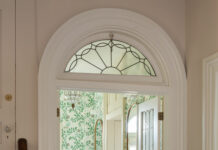When Barbara Peters moved into her Fenwick Island beachfront home in 1996, she dubbed the expanse between her deck and the beach “the Sahara desert.” Ten years later, it’s fair to say Peters has made that desert bloom.
“People think you can’t grow anything in the sand,” says Peters, a longtime gardener and one of the founders of the Fenwick Island-based Barefoot Gardeners club, a member of the Federated Garden Clubs of America. “I’m here to say you can.”
Indeed, from April to October, a mix of perennials, succulents and annuals thrives in Peters’ yard against a backdrop of blue, blue sea. Far from banishing the native yuccas and beach grass, Peters welcomes them, cutting the dried yucca stalks and spreading the seeds each fall. Come June, her efforts pay off when the spiny plants send up stalks bearing bell-shaped ivory blossoms. “The yucca is beautiful when it blooms,” she says. “And it and the beach grass really hold the dunes. Anything that holds the dunes, I like.”
Peters also has an affection for the out-of-the-ordinary and outrageous, which is reflected in her garden’s casual, playful aesthetic. “I wanted it to be really beach house-looking, full of whimsy, happy and fun,” she says.
In April, the yard explodes in a profusion of color, thanks to a collection of 1,000 bulbs that includes orange tulips, narcissus, blue muscari and fritalaria, a 2-foot-tall black-blossomed plant. “I just wanted to try planting bulbs,” she says. “It’s unheard of at the beach, but it works!” How did she know it would work? She didn’t. But she’s always game for a gardening adventure, and in the decade she’s been experimenting, she’s learned a lot.
From then on, most of the color comes from perennials. Yarrow and cotton lavender provide bolts of yellow, while rosa rugosa, a common beach-loving plant, and ice plant sport bright fuchsia blooms. Purple-blooming lavender and Russian sage complete the festive spread. Artemisia, sedum and blue fescue— all quite hardy— offer shades of silver and green. And in early fall, they turn shades of rust, gold and maroon, making October a lovely time to be at the beach house, says Peters.
Even more than in the garden itself, Peters’ flair for the dramatic is represented by the abundance and variety of containers that thrive on her home’s decks. She adores succulents because “they’re so crazy-looking”— and because they’re hardy. “Succulents are perfect for the beach because they need no water and no food,” she says. “I bring all the pots inside in the winter and give them no attention, and they do great.” One year, she filled the window box above her front door with plants that needed constant watering. Now she fills that box with succulents, including century plant, kalanchoe and sedum ‘Donkey Tail,’ which trails down around the doorway. “Never have I had to give them even a pitcher of water,” she says. “The more you abuse them, the better they do.”
Peters also plants the succulents in containers as solos— like the kalanchoe, with its striking red-tipped leaves, that sits at the street entrance to her home in a turquoise planter— or in combination with others, like the black-leafed Aeonium Zwartkof surrounded by trailing ice plant. Also on her decks, generously sized planters are filled with Japanese black pines and miscanthus, while pink-blossomed loosestrife grows against the house. (It’s invasive in some areas but not in sandy soil.) A thriving moon vine bears flowers that open in late afternoon, perfuming the air throughout the evening.
In the portion of Peters’ yard that faces the street, daylilies, Shasta daisies, coleus, sedum ‘autumn joy’ and coreopsis ‘moonbeam’ grow around a hand-painted birdhouse, given to Peters by a neighbor. Prickly pear grows in galvanized washtubs and in the ground by the telephone pole. It blooms yellow in midsummer and bears an edible fruit late in the season—and its prickliness discourages dogs from “congregating” around the telephone pole.
Itching for a new project, Peters recently commissioned her longtime landscape collaborator Mike Carver to section off part of her gravel driveway and create a small patio where she can sit when it’s too windy on the beach side of her home. Of course she didn’t want an ordinary patio—no brick or paving stones. Instead, Carver sunk a wrought-iron sun face into a disc of concrete, inlaid it with turquoise, green and yellow glass tiles and surrounded it with Tennessee fieldstones shaped like sunrays.
“No one has seen anything like this,” says Peters. “It’s wild.”




